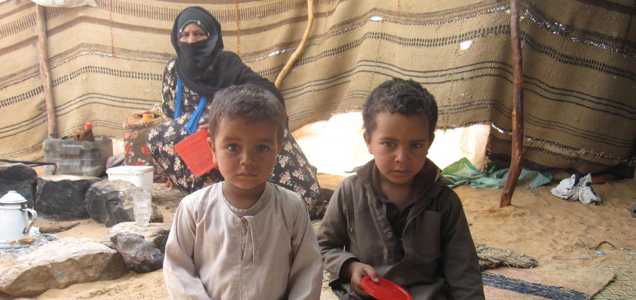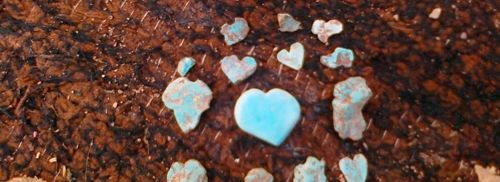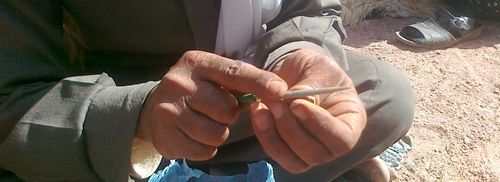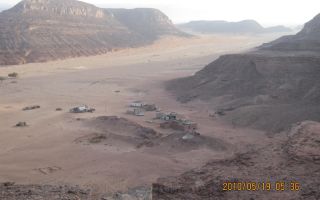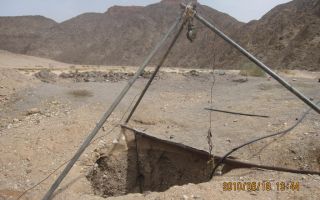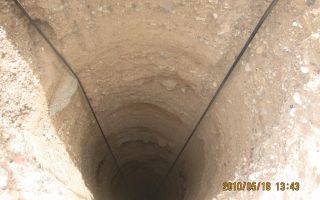In the mountains
till June 2016
The number of tourists visiting the mountains has dropped during the last couple of years. The tourists were actually supplying the Bedouins with work and livelihood. Now they hardly have an opportunity to earn money honestly. Some find work in sandpits that dig glass-sand, others work in ore pits. The third group tries to get turquoise in the mountain, which is more like a game of pure chance. It is being sold way too cheaply. [Nbsp]
Our employee started to process untreated turquois (celestial stone). The Bedouins took the diamond files into their hands and started at first very hesitantly, then with more enthusiasm, to process the rusty pebbles into a marvelous turquoise jewels.
However since there are no tourists who would buy this beautiful jewelry, the Bedouins often loose the motivation for their job. People living far away from stores, in the mountains, are really struggling financially. So we never go there with empty hands, but take along gifts like: fruits, vegetables, noodles, rice and lentils, which is highly appreciated by the Bedouins. We also look for ways to sell the jewelry at a good price.
Our employee is now working back in Germany. Would someone like to use his/her expertise to help the Bedoin and other people, to improve their lives quality?
Please contact us!
Through diligent work the desert turns into a green garden
Lasting change requires time
The oasis is inhabited by 50,000 bedouins who spread out through ten bigger cities, villages and hamlets. Till about 3 years ago their main source of income was tourism, this however isn`t the case anymore. The bedouins have to go back to their original work and keep up a farmer`s life.
Through diligent work the desert around the bedouin villages becomes more green. Income from the palm groves, clover fields, poultry and cattle breeding has replaced the tourism income. Some have turned their back on tourism even before, they bought huge landscapes and dug out deep wells. At that time the land was still a desert, now it`s a green garden. In the stables the cows, sheep, goats and poultry are increasing in numbers and to manage the big work load a few extra workers have been hired.
Most cows in the oasis are fed with clover and are very skiny. For years now we have been teaching the farmers to feed their cows with lots of grass, preferably even adding hey to it. This way they are better well-fed and give more milk. In ourdays the cows are big and look much better. They are fed with grass and hey and the results are immense. With joy and pride the farmers tell us, that their cows are now as big and fat as the cows in Germany. To see such a positive change makes us happy.
The bedouins usually are very thankful for the technical advice we give and are very encouraged when they see how well it works. Their vehicles function more reliable and they can rent them out to big oil companys to earn money. Since this culture is bound to their traditions, changes take a lot of time.
But there is hope. After a long period of time consolting, showing love to the people, learning and appreciatiating their culture and language, changes do come. When "the new idea" implemented by one of the farmers is successful, there soon will be others to follow his lead.
Through big conferences, expensive speakers and negotiations with politicians only small things improve for this people. What we need is: people who are willing to share the life of the bedouins and who have learned to survive with limited access to technical prosperity.
Gaining water in the desert
In the future we are planning to find finances and build tanks, so the Bedouins are not depending on the expensive water, "imported" from the big cities. This should encourage the Bedouins on small parts of their land to plant iron- mineral- and vitamincontaining plants like parsley, dill, tomatoes, cucumbers, rucola, etc. Some Bedouins already have build their own wells, but they are really expensive, about 10,000 Euro each. Now its important to help them find ways to purify and store the water. Unfortunately this water isn`t always suitable as drinking water. However, it can be used to water the plants.
The Bedouins are encouraged to use their houseroof to catch water and through gutter-pipes collect this water in tanks. We are thinking of tanks to hold about 3000 liters. This would be an inexpensive option, since they already have the roof surfaces sealed and a local company would be willing to sell containers of 1000 ltrs to Bedouins for a good price.
The next step would be to clear the water that comes down from the mountains and to get rid of stones, sand and other materials, using Syphonfilters. Afterwards the water can be stored in big tanks. For the storage tanks of about 100m² would be practical.





